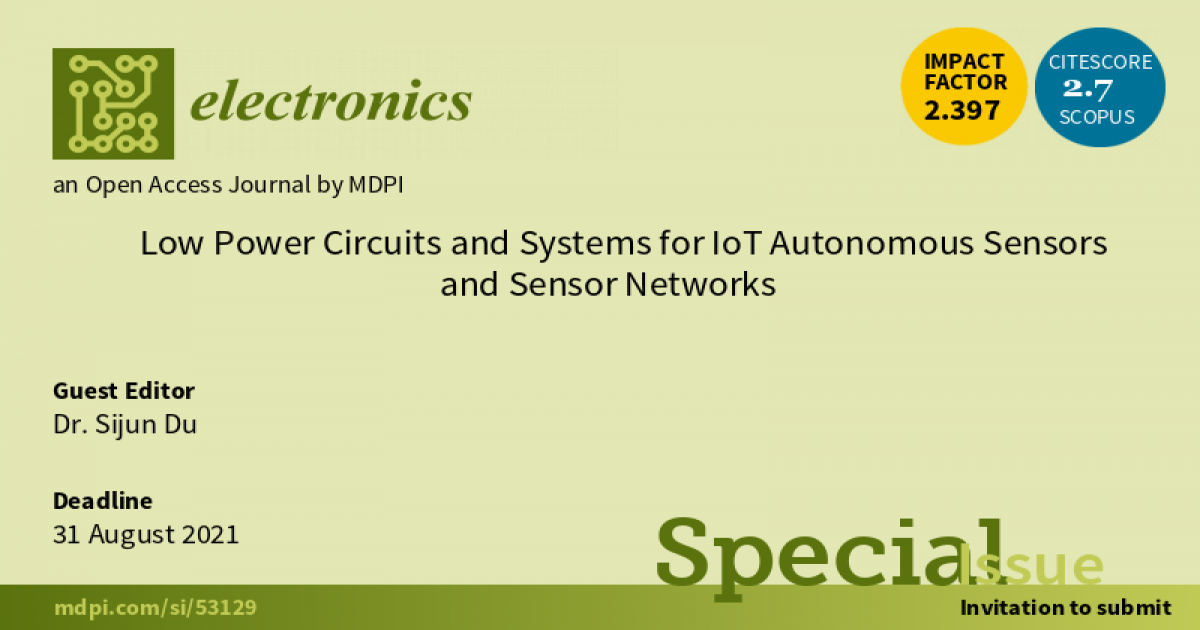Low Power Circuits and Systems for IoT Autonomous Sensors and Sensor Networks
A special issue of Electronics (ISSN 2079-9292). This special issue belongs to the section "Circuit and Signal Processing".
Deadline for manuscript submissions: closed (31 August 2021) | Viewed by 14337

Special Issue Editor
Interests: microelectronics; ultra-low power-integrated circuits; Internet of Things (IoT); autonomous sensors; energy harvesting; wireless power/data transfer; power conversion; renewable energy; wearable electronics; biomedical electronics; microrobotics
Special Issue Information
Dear Colleagues,
Along with the recent advances in the Internet of Things (IoT), sensors are playing an important role in connecting the physical and the cyber worlds. Since IoT sensors are ubiquitously implemented, it is very impractical and costly to periodically charge or replace the batteries in these ubiquitous sensors. In order to make these IoT sensors autonomous and self-sustained, there are several feasible approaches, including harvesting energy from the environment, designing low power sensors and sensor interface circuits, and proposing low power data processing and wireless communication algorithms. This Special Issue will focus on emerging technologies in energy harvesting, power management, low power sensors, and sensor networks to make IoT wireless sensors fully self-sustained or to significantly prolong the battery lifetime with circuit-, system-, and algorithm-level designs. We invite authors to contribute original research articles, as well as review articles, which advance the state-of-the-art with innovative solutions for self-sustained or significantly prolonged battery-life IoT wireless sensors.
The topics of this Special Issue will include but are not limited to:
- Energy harvesting devices, circuits, and systems;
- Battery-less systems;
- Autonomous systems;
- Printed circuits;
- Remote sensing;
- Low power sensors;
- Sensor interface circuits;
- Low power analog/digital signal processing;
- Low power wireless communication;
- Design methodology for low power analog/digital systems.
Dr. Sijun Du
Guest Editor
Manuscript Submission Information
Manuscripts should be submitted online at www.mdpi.com by registering and logging in to this website. Once you are registered, click here to go to the submission form. Manuscripts can be submitted until the deadline. All submissions that pass pre-check are peer-reviewed. Accepted papers will be published continuously in the journal (as soon as accepted) and will be listed together on the special issue website. Research articles, review articles as well as short communications are invited. For planned papers, a title and short abstract (about 100 words) can be sent to the Editorial Office for announcement on this website.
Submitted manuscripts should not have been published previously, nor be under consideration for publication elsewhere (except conference proceedings papers). All manuscripts are thoroughly refereed through a single-blind peer-review process. A guide for authors and other relevant information for submission of manuscripts is available on the Instructions for Authors page. Electronics is an international peer-reviewed open access semimonthly journal published by MDPI.
Please visit the Instructions for Authors page before submitting a manuscript. The Article Processing Charge (APC) for publication in this open access journal is 2400 CHF (Swiss Francs). Submitted papers should be well formatted and use good English. Authors may use MDPI's English editing service prior to publication or during author revisions.
Keywords
- Low power
- Energy harvesting
- Sensors
- Sensor interface circuits
- Sensor networks
- Power management
- Power transfer
- Low power communication
- Internet of Things
- Autonomous systems
Benefits of Publishing in a Special Issue
- Ease of navigation: Grouping papers by topic helps scholars navigate broad scope journals more efficiently.
- Greater discoverability: Special Issues support the reach and impact of scientific research. Articles in Special Issues are more discoverable and cited more frequently.
- Expansion of research network: Special Issues facilitate connections among authors, fostering scientific collaborations.
- External promotion: Articles in Special Issues are often promoted through the journal's social media, increasing their visibility.
- e-Book format: Special Issues with more than 10 articles can be published as dedicated e-books, ensuring wide and rapid dissemination.
Further information on MDPI's Special Issue policies can be found here.





